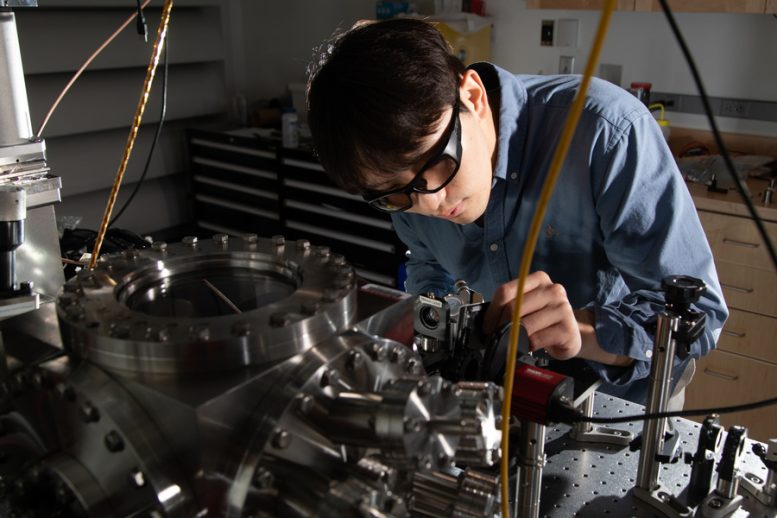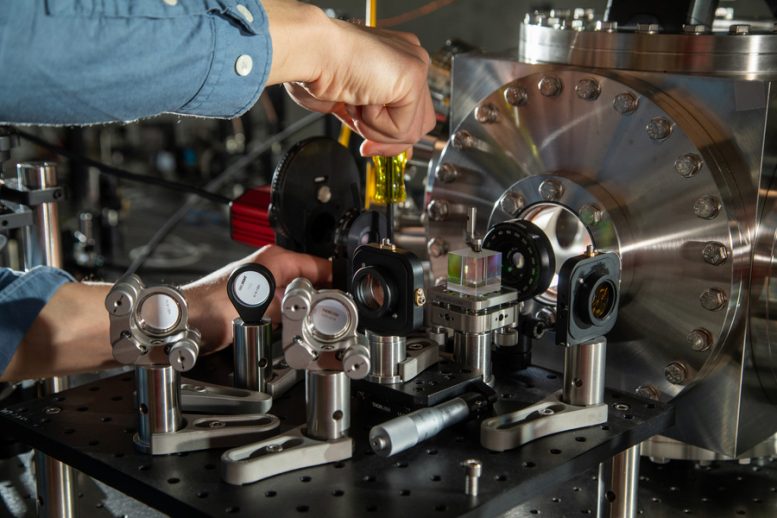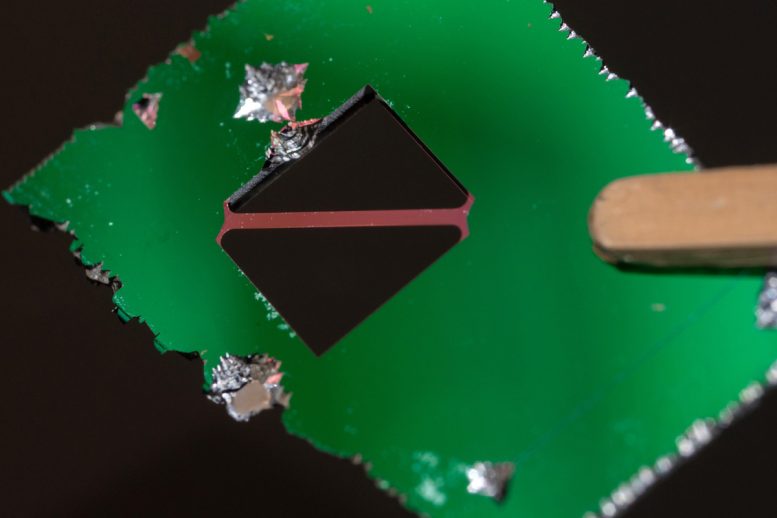
MIT researchers have found a bold new way to approach one of science’s biggest mysteries: is gravity truly a quantum force?
By chilling a tiny mirror to near absolute zero using lasers — a method traditionally used in atomic physics — they’ve opened a new experimental window into the intersection of quantum mechanics and gravity. This fusion of cutting-edge cooling and classical tools might finally let scientists observe whether gravity behaves like other quantum forces, a question that has puzzled physicists for decades.
The Gravity Puzzle: Is It Quantum?
One of the most profound open questions in modern physics is: “Is gravity quantum?”
While the other fundamental forces—electromagnetic, weak nuclear, and strong nuclear—have been successfully described by quantum theory, gravity still stands apart. So far, scientists haven’t been able to create a consistent quantum theory of gravity, leaving a major gap in our understanding of the universe.
“Theoretical physicists have proposed many possible scenarios, from gravity being inherently classical to fully quantum, but the debate remains unresolved because we’ve never had a clear way to test gravity’s quantum nature in the lab,” says Dongchel Shin, a PhD candidate in the MIT Department of Mechanical Engineering (MechE). “The key to answering this lies in preparing mechanical systems that are massive enough to feel gravity, yet quiet enough — quantum enough — to reveal how gravity interacts with them.”

A New Approach to Testing Gravity
Shin, who is also a MathWorks Fellow, works on experimental platforms that explore the frontiers of physics while laying the groundwork for future technologies. In a recent study, he and his team took a major step forward by successfully using lasers to cool a tiny mechanical device called a torsional oscillator. Their open-access paper, “Active laser cooling of a centimeter-scale torsional oscillator,” published in Optica, shows how this method could help reveal whether gravity behaves according to quantum rules.
Physicists have used lasers to cool atomic gases since the 1980s, and more recently to control the motion of nanoscale mechanical systems. But this is the first time anyone has applied laser cooling to a torsional oscillator—a tool that plays a central role in experiments that aim to uncover the true nature of gravity.
“Torsion pendulums have been classical tools for gravity research since [Henry] Cavendish’s famous experiment in 1798. They’ve been used to measure Newton’s gravitational constant, G, test the inverse-square law, and search for new gravitational phenomena,” explains Shin.

Merging Atomic Physics and Gravitational Tools
By using lasers to remove nearly all thermal motion from atoms, in recent decades scientists have created ultracold atomic gases at micro- and nanokelvin temperatures. These systems now power the world’s most precise clocks — optical lattice clocks — with timekeeping precision so high that they would gain or lose less than a second over the age of the universe.
“Historically, these two technologies developed separately — one in gravitational physics, the other in atomic and optical physics,” says Shin. “In our work, we bring them together. By applying laser cooling techniques originally developed for atoms to a centimeter-scale torsional oscillator, we try to bridge the classical and quantum worlds. This hybrid platform enables a new class of experiments — ones that could finally let us test whether gravity needs to be described by quantum theory.”

Cooling a Torsional Oscillator to 10 Millikelvin
The new paper demonstrates laser cooling of a centimeter-scale torsional oscillator from room temperature to a temperature of 10 millikelvins (1/1,000th of a kelvin) using a mirrored optical lever.
“An optical lever is a simple but powerful measurement technique: You shine a laser onto a mirror, and even a tiny tilt of the mirror causes the reflected beam to shift noticeably on a detector. This magnifies small angular motions into easily measurable signals,” explains Shin, noting that while the premise is simple, the team faced challenges in practice. “The laser beam itself can jitter slightly due to air currents, vibrations, or imperfections in the optics. These jitters can falsely appear as motion of the mirror, limiting our ability to measure true physical signals.”
To overcome this, the team used the mirrored optical lever approach, which employs a second, mirrored version of the laser beam to cancel out the unwanted jitter.
“One beam interacts with the torsional oscillator, while the other reflects off a corner-cube mirror, reversing any jitter without picking up the oscillator’s motion,” Shin says. “When the two beams are combined at the detector, the real signal from the oscillator is preserved, and the false motion from [the] laser jitter is canceled.”

Reaching Unprecedented Precision
This approach reduced noise by a factor of a thousand, which allowed the researchers to detect motion with extreme precision, nearly 10 times better than the oscillator’s own quantum zero-point fluctuations. “That level of sensitivity made it possible for us to cool the system down to just 10 milli-kelvins using laser light,” Shin says.
Shin says this work is just the beginning. “While we’ve achieved quantum-limited precision below the zero-point motion of the oscillator, reaching the actual quantum ground state remains our next goal,” he says. “To do that, we’ll need to further strengthen the optical interaction — using an optical cavity that amplifies angular signals, or optical trapping strategies. These improvements could open the door to experiments where two such oscillators interact only through gravity, allowing us to directly test whether gravity is quantum or not.”
The paper’s other authors from the Department of Mechanical Engineering include Vivishek Sudhir, assistant professor of mechanical engineering and the Class of 1957 Career Development Professor, and PhD candidate Dylan Fife. Additional authors are Tina Heyward and Rajesh Menon of the Department of Electrical and Computer Engineering at the University of Utah. Shin and Fife are both members of Sudhir’s lab, the Quantum and Precision Measurements Group.
The Power of Mechanical Engineering
Shin says one thing he’s come to appreciate through this work is the breadth of the challenge the team is tackling. “Studying quantum aspects of gravity experimentally doesn’t just require deep understanding of physics — relativity, quantum mechanics — but also demands hands-on expertise in system design, nanofabrication, optics, control, and electronics,” he says.
“Having a background in mechanical engineering, which spans both the theoretical and practical aspects of physical systems, gave me the right perspective to navigate and contribute meaningfully across these diverse domains,” says Shin. “It’s been incredibly rewarding to see how this broad training can help tackle one of the most fundamental questions in science.”
Reference: “Active laser cooling of a centimeter-scale torsional oscillator” by Dong-Chel Shin, Rajesh Menon, Vivishek Sudhir, Dylan Fife and Tina M. Hayward, 19 April 2025, Optica.
DOI: 10.1364/OPTICA.548098
Never miss a breakthrough: Join the SciTechDaily newsletter.
21 Comments
From a layman’s point of view what is being tested is gravity the same as entanglement , gravity is more prevalent with large scale objects but entanglement is at the scale of quantum . Big brother or little brother what holds things together . A relation of each other over time .
The span of disciplines required to pull off this experiment successfully is wide, they are really pushing the boundaries of the scientific envelope, I wish you and your team well Mr chin, good luck, I look forward to reading the watered down version of your observations, and hope the experiment is repeatable, so we can open up new avenues and be better informed on the nature of gravity and it’s mysteries. I really appreciate and respect your passion.
Science is Religion.
Except it
isn’t.
Religion is about believing in things that can never be seen or proven. Science is about not believing things until they can be seen or proven.
Like DM and DE…?
A Unified Graviton Field Theory: Reinterpreting Mass, Gravity, and Cosmic Expansion as Manifestations of Repulsive Energy Quanta
Abstract: This article proposes a novel theoretical framework centered on a new fundamental particle: the “monopole, massless graviton.” Unlike conventional gravitational theories, this model posits that these gravitons permeate the universe as fundamental energy quanta, and intrinsically repel one another, acting as the primary constituent of dark energy and driving cosmic expansion. Crucially, mass is redefined not as an inherent property of particles but as an emergent phenomenon resulting from the interaction and “bonding” of these ubiquitous gravitons with localized energy configurations (what we perceive as particles). Gravity, traditionally conceived as an attractive force, is reinterpreted as a net “push” exerted by the ambient, repelling graviton field upon these graviton-laden mass-energy configurations. This unified hypothesis offers a mechanistic explanation for mass, the nature of gravitational interaction, and the observed accelerated expansion of the universe, and suggests pathways for non-kinetic energy harvesting.
1. Introduction: The Enigmas of Modern Physics Despite the profound successes of the Standard Model of particle physics and General Relativity, several fundamental enigmas persist. The origin of mass, the nature of gravity at the quantum level, the accelerating expansion of the universe attributed to “dark energy,” and the lack of a unified theory of quantum gravity remain significant challenges. Current approaches often require disparate explanations: the Higgs mechanism for elementary particle mass, QCD for composite particle mass, gravitons as theoretical mediators of an attractive force, and dark energy as an exotic, unknown component. This article introduces an alternative perspective, suggesting that a single, fundamental energy constituent—a repulsive “monopole, massless graviton”—could provide a unified explanation for these phenomena, offering a departure from the conventional view of particles and forces.
Oh. OK
Fred brings up ‘the accelerating expansion of the universe attributed to dark energy’ as an enigma rather than a misunderstanding of lightspeed and red-shifting. Some of us believe in ‘tired light’ as the explanation of red-shift, not that things are expanding, but that light is slowed by the enormous amounts of mass in the universe it passes through. If you can believe light can’t escape the gravity of a black hole, why is it so hard to believe that a photon can be slowed just a little bit by the massive objects it passes by during the thousands/ millions/ billions of years they’re traveling on the way to your photodetectors?
Also consider that not all light behaves equally (ie as a wave or as a particle) and that not light is emitted from a single type of source (ie. Stars), nor do they all arrive to us as observers at the same wavelength. so light is itself variant. The James Web Telescope made this even more abundantly clear when it detected what were otherwise “invisible” galaxies beyond the vision of our previous telescopes.
You can’t really believe in “slow light” and seriously be posting in a science column. Photons don’t work like that. They have the same energy vector they start with until they “share it with something”. The only way to change your perception of that energy is to change the shape of the intervening space. In this case it’s the birthpoint – the twist in quantum reality that popped this universe out.
So, no. Red and blue shift is real. Stop trying to weasel out.
Quantum physics is fun, and there’s a whole bunch of amazing new toys as soon as people get over Nils Bohr. Don’t take that the wrong way. The physicists know what I mean. But gravity isn’t part of the Unified Field Theory. It isn’t even a force. It’s an artifact of geometry.
Sorry.
WRAPPING MY MIND AROUND the ‘fundamental energy constituent—a repulsive “monopole, massless graviton”—could provide a unified explanation as to’ EXPLAIN HOW WE EITHER JUMP ON EARTH, OR ARE NOT FORCED INTO SPACE. Covalent bonding?
Gravity isn’t a force, it’s a function of geometry in spacetime, they just haven’t got it accurately depicted yet because the time distortion isnt being accounted for fully with current measurments.
Won’t make much difference in our everyday lives, will it?
That depends on how interesting your everyday life is. If you’re not interested, your life is missing something.
Maybe, but if you’re that invested in answers from quantum physics – then you’ve got no life at all.
Anyway, so what if they find out the nature of gravity? Will that make you able to fly?
Eventually
No. It means we would be able to manipulate it in space so we’re not floating around everywhere. Also, we would be able to manipulate gravity in front and behind a spacecraft…
Riiiight, I have a feeling that you have read the “Mission Earth” series.
That’s what they said about cellphones and the internet…
This is old news, the question has been answered. All four of the fundamental forces are produced by quantum symmetry. Catch up. The theory has been posited, we are on the verge of GUT.